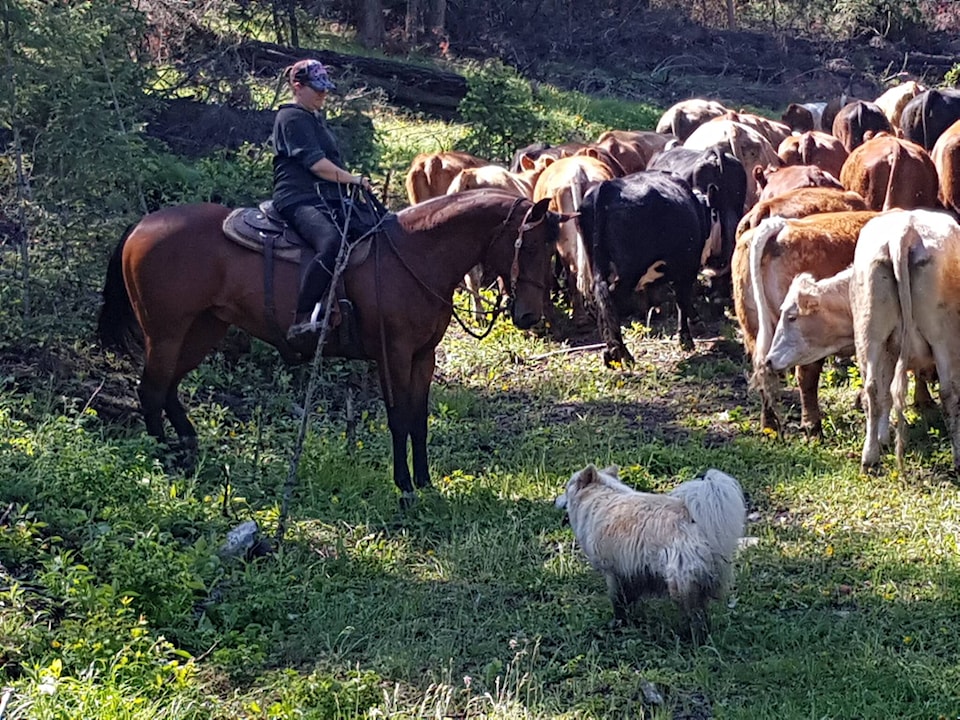With wildfires glutinously eating rangeland, and drought frying fields, the ranching industry is another casualty of the summer of ‘23.
These conditions have triggered mass sell-offs of cattle herds, a shortage in winter feed, and a spike in hay prices. Grazing is a forefront need, now, for the cattle setor. The longer cattle can eat the grasses around their home base, without abusing the root system, the better the area’s ranchers will be able to weather this lack of rain and bush eating.
Just prior to this challenging season, Quesnel was the site, along with 100 Mile House, of a scientific study specifically on the characteristics of local grazing. Specifically, the project asked about grazing in areas of shrubbery, notably in those fringe spaces bordering forests where agricultural inactivity can lead to the growth of young trees and shrubs slowly taking over the pasture or field. Could grazing cattle beat back that encroachment?
“The multi-functional pasture rejuvenation project is a collaborative effort to determine economic operationally feasible methods for producers and managers to reduce the negative impacts of woody plant encroachment,” said the authors of the study. They include Dr. John Church of Thompson Rivers University, Serena Black of the BC Forage Council, Keenan Baker of Thompson Rivers University, and project lead Dr. Lauchlan Fraser of Thompson Rivers University.
“This environmental change occurs when woody species such as shrubs and trees begin to encroach on grasslands and pastureland, reducing available edible species and limiting movement of livestock,” said their report. “To investigate various methods, two main ranches were set up as test sites,” the report continued. “Results from these sites are still being analyzed but preliminary data from two years of establishment has been promising. Seeding alone with no additional treatment has been found to increase forb (herbaceous flowering plants other than grass) cover. Grazing has proved a successful method of reducing shrub cover in these pastures and after enough time, could result in promotion of additional forb and grass cover with the benefit of seeding. More data is required to further test this idea but the first two years of this project have added useful information to the understanding of woody plant encroachment and its affects on pastures, as well as finding suitable methods of removal.”
The two years of investigation, so far, was not enough, according to the report, to come to definitive conclusions. Tracking biodiversity results is one particular area the scientists considered important.
“The apparent effectiveness of grazing to reduce regrowth of brush cut woody species (aspen and snowberry) shows that cattle can enact change through simple grazing,” the report said. “The data collected so far corroborates this finding, with grazed areas representing a significant decrease in shrub cover compared to areas with exclusion. These results point to grazing as a useful mechanism for reducing woody plant encroachment when those plants are mainly shrubs. This, combined with seeding, could lead to increased abundance of palatable species for livestock and a reduction in woody plants in affected pastures.”
This might be a perfect year for local ranchers to test these conclusions on their own landscapes, giving cattle extra time grazing those fringe areas, and perhaps accomplishing both extra calories for the herd and some extra grazing areas in the future.
READ MORE: B.C. ranchers struggle as drought sends hay prices soaring
READ MORE: RANCH MUSINGS: To hay or not to hay? - Haymaking business is nerve-wracking
***
Don’t miss out on your local news. Direct access is only a couple of clicks away, to have the paper delivered, or get the daily updates…
